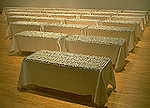ORIGINALLY PUBLISHED IN:

www.reviewny.com
November 1, 2000.

Allan McCollum.
THE EVENT:
Petrified Lightning
from Central Florida
(with supplemental
didactics). 2000.
Friedrich Petzel Gallery
through November 24
By Amy Jean Porter
ORIGINALLY PUBLISHED IN:
www.reviewny.com
November 1, 2000.

Allan McCollum.
THE EVENT:
Petrified Lightning
from Central Florida
(with supplemental
didactics). 2000.
Friedrich Petzel Gallery
through November 24
By Amy Jean Porter
'Florida's Fantastic Fulgurite Find,' by Fred W. Wright, Jr. is displayed alongside 'Fulgurites while You Wait' by
Mathilda Newman Reed. There are essays from Camp Blanding and References to Lightning in the Holy Bible
(http://wvlightning.com/bible.html). The bizarre literature may seem surreal, but as it turns out, the
surreal is all very real for the fulgurites. Allan McCollum's latest investigation into the nature of meaning,
collection, the copy, and the literal piles of literature surrounding it all takes the scientific phenomenon of the
fulgurite in an ironic attempt at the iconic.
Like McCollum's most famous Plaster Surrogates of yesteryear, the fulgurites involve a process of copying and
reproduction. McCollum, who collaborated with a geologist and an electrical engineer from the University of Florida,
collected and made casts of fulgurites so that the gallery exhibition includes thousands. A fulgurite is a geological oddity
formed when lightning strikes dry sand. The lightning creates glass columns (fulgurites) that exactly duplicate the path of
the lightning bolt. Fulgurites can be triggered and formed with the right equipment. McCollum's team at the University of
Florida launched small rockets directly into storm clouds with hair-thin copper wires trailing behind. These rockets triggered
lightning bolts that were directed down the wires into containers filled with minerals and sand. McCollum then excavated
the fulgurites from the sand and chose a select few to be replicated by a local souvenir manufacturer.
The Event is thus comprised of two adjacent rooms, one filled with tables covered by souvenir-style fulgurites, the other
filled with tables laden with over 13,000 small booklets with approximately seventy titles (a few of which are mentioned
above).
McCollum quite aptly identifies the creation of meaning in objects and the necessity of a cultural language-baggage that
forms and solidifies meaning. He says, "It's hard to imagine how memory and meaning could exist without language -
both are always only available through some sort of representation." The nature of collection is thus truly a collection of
discourse and McCollum makes us question the nature of this discourse. Why do certain objects become worthy of cultural
significance, or at a more basic level, why do we have the need to keep and collect? Lightning is the most instantaneous
of events, over before it happens. McCollum's inquiry is an extreme example of how at some point the event is long gone
and all that remains is the discourse. It is the literature that keeps it alive (even if there is no point in keeping it alive).
McCollum's suggestion is that all objects of significance should be shown with their "supplemental didactics," "Perhaps a
true picture of how an artwork has meaning could be constructed if the literature supporting the artwork was put on display
at the same time, along with it."
Objects also obtain significance through replication and reproduction, there is a desire to copy and a desire to own.
Souvenir-style objects become meaningful, although as things-in-themselves most do not merit significance. The
fulgurite, this very unassuming natural phenomenon cast from above becomes, in its new shiny-gallery-in-Chelsea
context, a strange icon, ready to be talked about and collected (just as the exhibition The Event is generating its own
collection of discourse). And it is the discourse rather than the somewhat ugly thing-in-itself fulgurite (or the bizarre
display of thousands of them in McCollum's exhibition) that holds significance.
Friedrich Petzel Gallery
535 West 22nd Street
New York City NY 10011
212. 680-9467